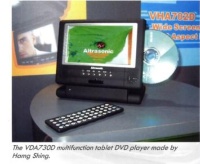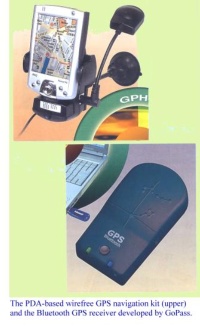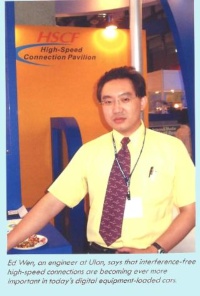Auto Electronics Spotlighted At Computex
Oct 14, 2005 Ι Industry News Ι Auto Parts and Accessories Ι By Quincy, CENS
An increasing number of local makers of information-technology (IT) and electronics equipment are reinvigorating growth with the debut of new auto-electronics products, many of which were highlighted at the recent 2005 Taipei International Computer Show (Computex Taipei 2005), one of the world's top three computer and consumer electronics shows.
Mio Technology Ltd., a subsidiary of MiTAC International Corp., introduced its Mio handheld global positioning system (GPS) navigation device at the Cartonics Pavilion. Two models were on show--the Mio 169, a PDA/GPS device with landscape display, and the Mio 268, a portable navigation system for drivers.
Pure GPS Navigation
Mio Technology's stylish mobile-navigation systems easily fit in pocket or purse. The antenna on the Mio 268 is embedded in the device for greater durability and convenience.
The Mio 268 comes in black and metallic colors with buttons set off by the blue LED lights. The device is designed for quick installation and removal so drivers can conveniently use it in multiple vehicles.
On the Mio 169, a hotkey makes it easy to switch between portrait and landscape views of the called-up electronic map, and an audio system announces step-by-step driving instructions.
Another model showcased by Mio Technology was the Mio 168RS, which provides a more intuitive way to grasp road conditions and routes. With the high-sensitivity GPS reception system and large keys for easy operation, the Mio 168RS is the perfect companion for driving, riding and walking. The model also includes all the powerful functionality of a pocket PC, letting you manage your schedule, work documents, and business data on the go.
According to market analysts Canalys, Mio Technology has become the No. 2 vendor of integrated GPS mobile devices in Europe, the Middle East and Africa, with a market share of 14.4% in first quarter of 2005, according to Sammy Huang, public relations specialist at the company. Mio Technology also supplies such products under OEM/ODM basis to several leading European brands. Last year, Mio Technology shipped about one million mobile GPS navigation models, and the volume is expected to double this year, Huang says.
Multifunctional Tablet DVD Player
Another eye-catching item on display this year was a mobile DVD player developed by Hamg Shing Technology Corp., a leading auto-electronics system maker in Taiwan.
The VDA730D integrates a seven-inch thin film transistor-liquid crystal display (TFT-LCD) monitor (16:9 wide-screen), a slot-in type DVD player, a lithium-ion battery pack delivering at least 2.5 hours of playback, and a card-reader. The portable device weighs only 820 kilograms (without battery), can be applied onto the front-seat head cushions or positioned anywhere you want. It also comes with a remote control and supports most mainstream formats and media.
According to Hamg Shing, tablet DVD players are gaining popularity in the in-auto multimedia market. Few local makers are producing such products, he adds, due to the high threshold for system integration and circuit design ability.
The Hamg Shing says the new device is selling well, with orders flooding in from Europe and the U.S. His company has been ramping up production capacity to meet the strong demand. Hamg Shing is actively working on a GPS navigation module, which will be built into the tablet device, as well as a 10.2-inch model for the upper end of the market. Hamg Shing globally markets the tablet DVD player under the "Altrasonic" brand.
Hamg Shing currently operates four plants, including three in Taiwan and one in mainland China, with over 3, 000 employees combined.
DVB Solutions
Visson Technologies Inc., a subsidiary of the VIA Group, a leading chip-design conglomerate in Taiwan, claims that it is the No.1 digital-video broadcasting (DVB) solutions provider in Taiwan.
Visson supplies DVB solutions for terrestrial, cable and satellite systems, as well as products for automotive, PC, handheld-device, and family applications.
Anthony Lai, special assistant to president at Visson, claims that Visson was the first Taiwan company to overcome the Doppler effect in DVB-T receiving by developing a dual-antenna in-vehicle DVB-T TV receiver.
Visson's competitiveness in DVB-technology fields lies mainly in its leading R&D, manufacturing and quality control. Visson adopts key chipsets supplied mainly by Dibcom (which accounts for about 95% of the global share) as well as core chips from Fujitsu and STMicroelectronics. "The resolution of our DVB-T receiver is similar, or a little bit better, than general counterparts, " Lai says. "But we are ahead of other local firms in the other more-important factors needed to make a good DVB-T receiver, including mechanisms, software/hardware integration, antennas, heat dissipation, signal reception, and decoding ability."
Visson's 30-person R&D team has developed an innovative indoor printed antenna for in-car DVB-T receiver systems, a heat-dissipation solution that obviate the need for in-case cooling fans, a universal interface (UI) that greatly enhances extendibility and compatibility, and a graphical boot screen.
Visson recently unveiled the world's first GPS navigation/DVB-T on-board unit, the A2000T, for both the original equipment (OE) and aftermarket (AM) sales by integrating mature GPS navigation technologies from VIA. Currently, no other company in the world has developed a device that integrates both in-auto stereo system and the DVB-T receiver due mainly to bottlenecks in heat-dissipation, modularization and chipset development.
In addition, Visson is also targeting the handheld sector and trying to integrate different systems such as Bluetooth capability, consumer electronics, multimedia systems, and digital audio broadcasting (DAB) systems. The company has started a series of cooperation projects with local TV and bus companies to jointly develop the DVB-T business.
In Taiwan, Visson is the only maker of terrestrial DVB-T systems.
PDA-Based WireFree GPS-Navigation Kit
Another interesting gadget on show at Computex was a PDA-based wirefree GPS-navigation kit developed by GoPass Technology Corp.
The device, which resembles a hands-free car kit for cell phones, integrates a GPS receiver on a flexible tube (to improve signal reception), built-in speakers for voice navigation guide, changeable connector base to fit almost all PDA models, and a strong suction cup to firmly and easily attach the device to the windshield. Operation is a breeze --just put your PDA into the kit and you're ready to go.
GoPass also demonstrated a Bluetooth GPS receiver with built-in GPS/Bluetooth modules, li-ion battery for up to 20 hours of operation time, LED indicators of GPS, battery and Bluetooth status, low-noise, high-sensitivity active antenna. The compact device can be connected wirelessly to handheld devices to deliver GPS navigation functions.
High-Speed Connection
Getting all of your on-board electronics to work seamlessly together becomes more complicated as the number of such devices multiplies.
Ed Wen, an engineer at Ulan Co., Ltd. A high-speed connection-solutions provider, says that the connection interfaces currently adopted by automakers worldwide are different and hard to unify. Some luxury car brands, however, have started adopting the speedy IEE1394 interface to handle data transmissions between in-car computers, multimedia systems, and other electronic systems.
"As the volume of data transmission grows, in-car high-speed connection has become a major issue for automakers, " Wen says. "Wider bandwidth is needed, but not every maker is going to use the IEE1394 interface."
High-speed connection interfaces, Wen says, also make independent car computers and electronics systems smarter and more functional. In each 1394 IC chip, Wen explains, there is a micro processor in the link layer and the smart processor can help achieve unlimited versatile applications if it is connected with other compatible chips in computing, alarm, surveillance, multimedia systems. That means, a smarter, stronger and more powerful nerve system for your car, he says.
The high-speed connection also creates more business for peripheral equipment and accessories, Wen adds, such as electromagnetically shielded cables. "As cars become more computerized, " Wen says, "interference increasingly affects data transmission among systems. When you step on the gas, for example, the static electricity may interfere with other electronics systems onboard. The environment is also filled with noise signals that can interfere with transmissions between in-car devices."
Wen says that confronting this problem will require the development of high-speed transmission and related peripherals. (June 2005)
Mio Technology Ltd., a subsidiary of MiTAC International Corp., introduced its Mio handheld global positioning system (GPS) navigation device at the Cartonics Pavilion. Two models were on show--the Mio 169, a PDA/GPS device with landscape display, and the Mio 268, a portable navigation system for drivers.
Pure GPS Navigation
Mio Technology's stylish mobile-navigation systems easily fit in pocket or purse. The antenna on the Mio 268 is embedded in the device for greater durability and convenience.
The Mio 268 comes in black and metallic colors with buttons set off by the blue LED lights. The device is designed for quick installation and removal so drivers can conveniently use it in multiple vehicles.
On the Mio 169, a hotkey makes it easy to switch between portrait and landscape views of the called-up electronic map, and an audio system announces step-by-step driving instructions.
Another model showcased by Mio Technology was the Mio 168RS, which provides a more intuitive way to grasp road conditions and routes. With the high-sensitivity GPS reception system and large keys for easy operation, the Mio 168RS is the perfect companion for driving, riding and walking. The model also includes all the powerful functionality of a pocket PC, letting you manage your schedule, work documents, and business data on the go.
According to market analysts Canalys, Mio Technology has become the No. 2 vendor of integrated GPS mobile devices in Europe, the Middle East and Africa, with a market share of 14.4% in first quarter of 2005, according to Sammy Huang, public relations specialist at the company. Mio Technology also supplies such products under OEM/ODM basis to several leading European brands. Last year, Mio Technology shipped about one million mobile GPS navigation models, and the volume is expected to double this year, Huang says.
Multifunctional Tablet DVD Player
Another eye-catching item on display this year was a mobile DVD player developed by Hamg Shing Technology Corp., a leading auto-electronics system maker in Taiwan.
The VDA730D integrates a seven-inch thin film transistor-liquid crystal display (TFT-LCD) monitor (16:9 wide-screen), a slot-in type DVD player, a lithium-ion battery pack delivering at least 2.5 hours of playback, and a card-reader. The portable device weighs only 820 kilograms (without battery), can be applied onto the front-seat head cushions or positioned anywhere you want. It also comes with a remote control and supports most mainstream formats and media.
According to Hamg Shing, tablet DVD players are gaining popularity in the in-auto multimedia market. Few local makers are producing such products, he adds, due to the high threshold for system integration and circuit design ability.
The Hamg Shing says the new device is selling well, with orders flooding in from Europe and the U.S. His company has been ramping up production capacity to meet the strong demand. Hamg Shing is actively working on a GPS navigation module, which will be built into the tablet device, as well as a 10.2-inch model for the upper end of the market. Hamg Shing globally markets the tablet DVD player under the "Altrasonic" brand.
Hamg Shing currently operates four plants, including three in Taiwan and one in mainland China, with over 3, 000 employees combined.
DVB Solutions
Visson Technologies Inc., a subsidiary of the VIA Group, a leading chip-design conglomerate in Taiwan, claims that it is the No.1 digital-video broadcasting (DVB) solutions provider in Taiwan.
Visson supplies DVB solutions for terrestrial, cable and satellite systems, as well as products for automotive, PC, handheld-device, and family applications.
Anthony Lai, special assistant to president at Visson, claims that Visson was the first Taiwan company to overcome the Doppler effect in DVB-T receiving by developing a dual-antenna in-vehicle DVB-T TV receiver.
Visson's competitiveness in DVB-technology fields lies mainly in its leading R&D, manufacturing and quality control. Visson adopts key chipsets supplied mainly by Dibcom (which accounts for about 95% of the global share) as well as core chips from Fujitsu and STMicroelectronics. "The resolution of our DVB-T receiver is similar, or a little bit better, than general counterparts, " Lai says. "But we are ahead of other local firms in the other more-important factors needed to make a good DVB-T receiver, including mechanisms, software/hardware integration, antennas, heat dissipation, signal reception, and decoding ability."
Visson's 30-person R&D team has developed an innovative indoor printed antenna for in-car DVB-T receiver systems, a heat-dissipation solution that obviate the need for in-case cooling fans, a universal interface (UI) that greatly enhances extendibility and compatibility, and a graphical boot screen.
Visson recently unveiled the world's first GPS navigation/DVB-T on-board unit, the A2000T, for both the original equipment (OE) and aftermarket (AM) sales by integrating mature GPS navigation technologies from VIA. Currently, no other company in the world has developed a device that integrates both in-auto stereo system and the DVB-T receiver due mainly to bottlenecks in heat-dissipation, modularization and chipset development.
In addition, Visson is also targeting the handheld sector and trying to integrate different systems such as Bluetooth capability, consumer electronics, multimedia systems, and digital audio broadcasting (DAB) systems. The company has started a series of cooperation projects with local TV and bus companies to jointly develop the DVB-T business.
In Taiwan, Visson is the only maker of terrestrial DVB-T systems.
PDA-Based WireFree GPS-Navigation Kit
Another interesting gadget on show at Computex was a PDA-based wirefree GPS-navigation kit developed by GoPass Technology Corp.
The device, which resembles a hands-free car kit for cell phones, integrates a GPS receiver on a flexible tube (to improve signal reception), built-in speakers for voice navigation guide, changeable connector base to fit almost all PDA models, and a strong suction cup to firmly and easily attach the device to the windshield. Operation is a breeze --just put your PDA into the kit and you're ready to go.
GoPass also demonstrated a Bluetooth GPS receiver with built-in GPS/Bluetooth modules, li-ion battery for up to 20 hours of operation time, LED indicators of GPS, battery and Bluetooth status, low-noise, high-sensitivity active antenna. The compact device can be connected wirelessly to handheld devices to deliver GPS navigation functions.
High-Speed Connection
Getting all of your on-board electronics to work seamlessly together becomes more complicated as the number of such devices multiplies.
Ed Wen, an engineer at Ulan Co., Ltd. A high-speed connection-solutions provider, says that the connection interfaces currently adopted by automakers worldwide are different and hard to unify. Some luxury car brands, however, have started adopting the speedy IEE1394 interface to handle data transmissions between in-car computers, multimedia systems, and other electronic systems.
"As the volume of data transmission grows, in-car high-speed connection has become a major issue for automakers, " Wen says. "Wider bandwidth is needed, but not every maker is going to use the IEE1394 interface."
High-speed connection interfaces, Wen says, also make independent car computers and electronics systems smarter and more functional. In each 1394 IC chip, Wen explains, there is a micro processor in the link layer and the smart processor can help achieve unlimited versatile applications if it is connected with other compatible chips in computing, alarm, surveillance, multimedia systems. That means, a smarter, stronger and more powerful nerve system for your car, he says.
The high-speed connection also creates more business for peripheral equipment and accessories, Wen adds, such as electromagnetically shielded cables. "As cars become more computerized, " Wen says, "interference increasingly affects data transmission among systems. When you step on the gas, for example, the static electricity may interfere with other electronics systems onboard. The environment is also filled with noise signals that can interfere with transmissions between in-car devices."
Wen says that confronting this problem will require the development of high-speed transmission and related peripherals. (June 2005)
©1995-2006 Copyright China Economic News Service All Rights Reserved.










